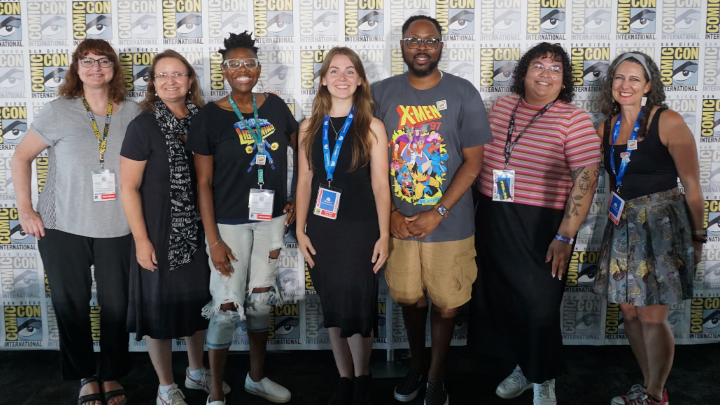K-12 teachers reflect on value of NEH Summer Institute
Diverse social justice themed presentations and assignments helped participants expand ideas for future classroom engagement.

“Using Comics to Teach Social Justice,” a professional development program funded by the National Endowment for the Humanities, brought 25 K-12 teachers from across the country to San Diego State University for two weeks last month. The program goal was to transform teaching of timely and challenging social issues by incorporating comics and graphic novels into the teachers’ curricula and lesson plans.
Center for Comics Studies co-directors Beth Pollard and Pamela Jackson developed a vibrant comics curriculum addressing social justice themes for teachers to take back to their own classrooms in hopes of creating profound impacts.
“Over the past few years, we’ve cultivated remarkable strengths in terms of comics-related research expertise, teaching, and collections,” said Pollard. “Given that SDSU is also such a leader in teacher education, it only made sense to blend those assets in a way that makes a difference far beyond the walls of the University.”
Selected from 202 applicants, teachers from 16 states attended the institute in late July at the University Library and off-campus locations that included Little Fish Comic Book Studio and the Comic-Con Museum. The institute culminated at San Diego Comic-Con International where four participants joined an SDSU panel at the San Diego Central Library.
During the institute, SDSU faculty experts discussed subjects ranging from banned books to comics and their place in public libraries to LGBTQ+ representation in comics. Participants noted they were not only interested in teaching their students to think critically as they read comics but in learning more about making comics.
From the University Library’s collection of more than 120,000 comics, Jackson gathered 130 books geared toward K-12 students on such subjects as immigration, racism, social justice, representation, and other areas of importance to the teachers.
Jackson said, “Comic book publications for children and young adults have skyrocketed in recent years. The challenge here was to select materials suitable for teachers at every grade level that they could use with students at every reading level, while also being mindful of the diverse social issues educators are grappling with including in their lesson plans.”
Library Dean Scott Walter said "I would have loved a program like this when I was a pre-service social studies teacher. My children’s lit class was great, but, comics, man, that would have been awesome."
SDSU faculty presentations included, Desmond Hassing, American Indian Studies lecturer, Brad Kirkegaard, Department for the Study of Religion lecturer, Jess Whatcott, women’s studies assistant professor, Bill Nericcio, English and comparative literature professor, Ajani Brown, Africana Studies lecturer, Van Tarpley, history lecturer, and Michael Domínguez, formerly an associate professor in Chicano/Chicana Studies (now at University of New Mexico). Other presenters included Betsy Gomez (American Library Association Office of Intellectual Freedom) and Moni Barrette (founder of Creators Assemble and a lecturer in the SDSU first-year success program). Katie Sciurba, formerly associate professor in education (now at University of Georgia) assisted participants in developing lesson plans related to the content they were encountering.
Local artist, writer, producer, and director Mark Habegger (‘93) led a three-hour comics-making workshop. One of his goals was to teach a method that helps teachers empower those students who think they cannot draw. In the field trip to Little Fish Comic Book Studio (where Habegger is a board member), teachers watched detailed instruction on making comics.
The Comic-Con museum field trip was led by Emily Schindler, director of education at the museum, who spoke about multiple literacies and multimodal texts. She also gave participants an assignment: look at an object in the museum and then write a critical analysis of it.
Participants in the institute were overwhelmingly positive about their experience.
- Darryl Hawkins, a K-5 school library media specialist from Georgia said, “I’ve always enjoyed comics and graphic novels and one of my goals is to find a way to bring more to my school. The institute did a good job of showcasing a diverse group of instructors who gave us different approaches. The best part of the institute for me was listening to all the professors on the different topics that breakdown social justice viewpoints. My second favorite part about the institute has been the field trips — especially the Comic-Con Museum. The institute has given me the opportunity to realize that I can pair academics and art in unique ways to support my community with different initiatives.”
- Marcella Brideson, a seventh-grade humanities teacher from North Carolina said, the social justice topic was precisely why she applied. “The program has awarded me so many wonderful opportunities and ways to learn new things and to implement new things in my classroom. They were able to infuse creativity within me that makes me feel confident and I’m going to be able to bring that back to my students. As teachers the best thing you can do is be so excited that your kids get excited too.
- Iwalani Wilson, is a sixth-grade social studies teacher from Virginia, who is entering her 20th year of teaching said, “I wanted to find something that I had not done before to engage my students. I recently discovered comics. I have a whole new view of comics — they’re not just fun words and pictures — they are actually wrestling with and tackling the big issues of the day. It was exciting and eye-opening.”



